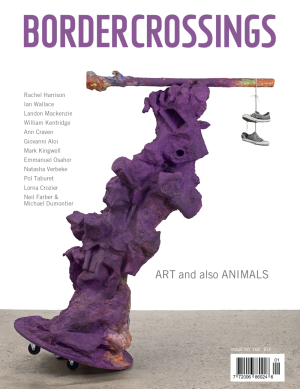Concertante: Arnold Spohr and the Royal Winnipeg Ballet
Concertante is a two-part celebration. It marks the commercial coming of age of the Winnipeg Film Group with a film of high technical quality which will receive national exposure on CBC television. It also celebrates Arnold Spohr’s long and remarkable tenure as artistic director of the Royal Winnipeg Ballet.
Actually, the film is just the latest in a series of tributes prompted by Spohr’s 25th anniversary with his dance company. There was a glittering gala performance with the presentation of a silver sports car and a fur coat. There were feature articles in both the local and national press full of words like “genius” and “visionary”. It was as if, overnight, everyone had become aware of what an important force Arnold Spohr has been in Canadian dance.
But it’s a little early for summing up, since Arnold Spohr shows little sign of slowing down, yet alone retiring, and Spohr’s strengths are not easily understood or explained. Before becoming artistic director he was not a great dancer, like Erik Bruhn, or a ground-breaking choreographer, like George Balanchine. Spohr’s skills are more those of the administrator and programmer, the teacher and coach—none of which talents are particularly photogenic.
On top of that, Spohr’s conversation tends to be rambling and cliché-ridden and his public speaking is decidedly uncharismatic. But despite these difficulties Gabriel and Jancarlo Markiw have managed to quite successfully capture some facets of this elusive character.
We learn fascinating things from people who have known and worked with Arnold Spohr over the years. His sister Erica tells how she wept in her bedroom until he finally agreed to accompany her to see the Ballets Russes de Monte Carlo. The basketball-playing teenager went reluctantly, but was transfixed by the performance. And the rest, as they say, is history.
Betty Farrally remembers the gangly youth coming to his ftrst dance classes with a brother, and she passes on the improbable piece of information that Arnold was the shortest member of his family.
John Hirsch tells how Spohr would actually hit his dancers as they came off stage if he didn’t feel they’d worked hard enough. Petal Miller, a former company member, recalls how her failure to manage 32 fouettés in performance caused an irate Spohr to shout, “I don’t pay you all that money to see it in the studio.” I’d wager that “all that money” amounted to no more than one hundred dollars a week.
While all this anecdotal material is interesting, the real insights come in the rehearsal sequence. Spohr is shown, typically enough, working on someone else’s ballet, L’Estro Harmonico by the late John Cranko.
The actual teaching of Cranko’s ballet by Alan Beale of the Stuttgart Ballet is given short shrift. The dancers applaud when Beale is introduced they take a few turns around the room and, presto, they’re turned over to Mr. Spohr. He proceeds to go over and over a phrase, fusses over a stiff arm or a lopsided shoulder, throws out dozens of allusions, one or two of which actually stick. There’s a touch of the tyrant in a remark like, “I don’t know what the heck you’re doing here, people!” and of the affectionate father in “See now Evvy, see how much better that is.”
And yes, we do see how much better it is. As the rehearsals progress and merge into performance we see the work grow, become clearer and more musical. The film shows us that Spohr really does have something.
And so does the film’s director, Gabriel Markiw. His year at ballet school probably helped him develop a sure eye for movement. And Ian Elkin, the cinematographer, seems to know exactly when to move in for a close-up and when to stand back to let us see the whole ensemble. Between them, they manage to make L’Estro Harmonico more impressive than I remember it on stage.
Despite the overall good looks and sound of the film, there are some serious problems with its structure. It’s ironic that a portrait of a man who admonishes his dancers to “keep it clear” isn’t very clear itself. It’s not always apparent who is speaking, where we are or even when. The filmmakers have decided to dispense with a narrator except for an occasional disembodied voice.
Perhaps the film doesn’t need a narrator but neither does it need sentimental closeups of a pensive Spohr in order to introduce a flashback. Nor does it need the obvious ‘set-up’ when the pilot on a trans-Atlantic flight comes back to ask his distinguished passenger where he’s going. Even Spohr’s answer doesn’t explain why there is so much travelogue footage of pigeons in Naples and steetcars in Geneva. Those scenes merely muddle the narrative.
Moments from the 25th anniversary gala are passed off as a regular ballet premiere and as a result create more confusion. Do all of Arnold Spohr’s friends from West Palm Beach, New York, and the North End routinely show up on opening night?
I must admit that some of the asides, especially of ballerina Evelyn Hart putting on her make-up while wearing a walkman, are fun. And I wanted more archival material of Spohr performing in corny old chestnuts like The Shooting of Dan McGrew. But finally, all the jumping around in space and time means we get neither a complete history of the Royal Winnipeg Ballet nor a record of Spohr’s role in it.
The film needs someone like Arnold Spohr himself to clearly arrange all that fascinating raw material. But the Markiw brothers do show some considerable promise as dance filmmakers and they have brought us a lot closer to understanding an enigmatic artist. Perhaps after 25 years of working at their art they will achieve clarity too. ♦
Jacqui Good, a co-host of the weekly cultural news magazine, Arts Encounter, also regularly reviews dance in Winnipeg for CBC Stereo Morning.

